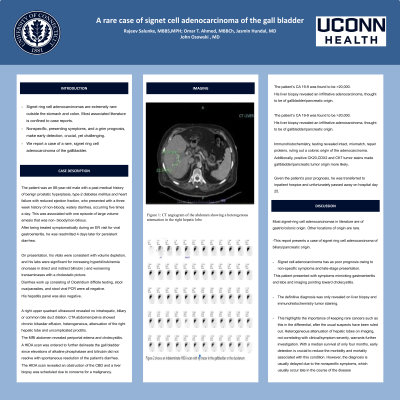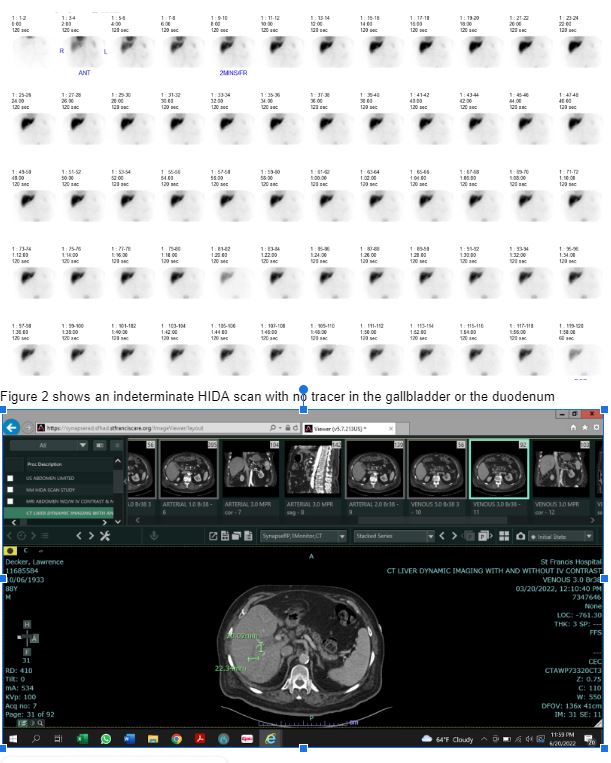Back


Poster Session E - Tuesday Afternoon
Category: Biliary/Pancreas
E0032 - A Rare Case of Signet Ring Cell Adenocarcinoma of the Gallbladder
Tuesday, October 25, 2022
3:00 PM – 5:00 PM ET
Location: Crown Ballroom

Has Audio

Rajeev Salunke, MBBS, MPH
University of Connecticut Health Center
Farmington, CT
Presenting Author(s)
Rajeev Salunke, MBBS, MPH1, Omar T. Ahmed, MBBCh2, Jasmin Hundal, MD1, John Osowski, MD3
1University of Connecticut Health Center, Farmington, CT; 2UConn Health, Farmington, CT; 3Saint Francis Hospital, Trinity Health of New England, Hartford, CT
Introduction: Signet-ring cell adenocarcinoma (SCA) are extremely rare outside the stomach and colon. The majority of the literature consisted of case reports. The nonspecific presenting symptoms and the dismal prognosis associated with this disease, makes early detection crucial but very challenging. We report a case of SCA with rare presentation.
Case Description/Methods: An 88-year-old male with a history of diabetes and CAD, presented with a 3-week history of watery diarrhea. On presentation, he had signs of dehydration. His labs were significant for worsening cholestatic liver injury with uprising AST 179 (to 266) U/L, ALT 149 (to 192) U/L, ALP 844 (to 1,660) U/L, total bilirubin of 2.3 (to 16.5) mg/dL, but normal lipase. Gastroenteritis was initially suspected, however, infectious workup was negative. RUQ US ruled out CBD dilatation. Dynamic CT of the liver revealed soft tissue lesion in porta hepatis with periportal edema and mild biliary dilatation in the right hepatic lobe. MRI/MRCP revealed findings consistent with acute cholecystitis but no biliary dilatation. On HIDA scan, tracer was not found in gallbladder or intestines. Liver biopsy revealed SCA and CA 19-9 level was >20,000 U/mL. Patient passed away 6 weeks after presentation.
Discussion: Our SCA is an aggressive and rare variant of adenocarcinoma, that is mostly reported in gastric or colonic cancers, and is extremely rare outside these two locations. It has poor prognosis, owing to its late stage presentation with nonspecific symptoms. Our patient presented with symptoms mimicking gastroenteritis and imaging was suggestive of acute cholecystitis, with some indication of biliary obstruction. Liver biopsy revealed SCA which was otherwise an unexpected diagnosis. This highlights the importance of keeping rare cancers such as this in the differential, after the usual suspects have been ruled out. Heterogeneous attenuation of hepatic lobes on imaging, not correlating with clinical/symptom severity, warrants further investigation. With a median survival of only four months, early detection is crucial to reduce the morbidity and mortality associated with this condition. However, the diagnosis is usually delayed due to the nonspecific symptoms, which usually occur late in the course of the disease.

Disclosures:
Rajeev Salunke, MBBS, MPH1, Omar T. Ahmed, MBBCh2, Jasmin Hundal, MD1, John Osowski, MD3. E0032 - A Rare Case of Signet Ring Cell Adenocarcinoma of the Gallbladder, ACG 2022 Annual Scientific Meeting Abstracts. Charlotte, NC: American College of Gastroenterology.
1University of Connecticut Health Center, Farmington, CT; 2UConn Health, Farmington, CT; 3Saint Francis Hospital, Trinity Health of New England, Hartford, CT
Introduction: Signet-ring cell adenocarcinoma (SCA) are extremely rare outside the stomach and colon. The majority of the literature consisted of case reports. The nonspecific presenting symptoms and the dismal prognosis associated with this disease, makes early detection crucial but very challenging. We report a case of SCA with rare presentation.
Case Description/Methods: An 88-year-old male with a history of diabetes and CAD, presented with a 3-week history of watery diarrhea. On presentation, he had signs of dehydration. His labs were significant for worsening cholestatic liver injury with uprising AST 179 (to 266) U/L, ALT 149 (to 192) U/L, ALP 844 (to 1,660) U/L, total bilirubin of 2.3 (to 16.5) mg/dL, but normal lipase. Gastroenteritis was initially suspected, however, infectious workup was negative. RUQ US ruled out CBD dilatation. Dynamic CT of the liver revealed soft tissue lesion in porta hepatis with periportal edema and mild biliary dilatation in the right hepatic lobe. MRI/MRCP revealed findings consistent with acute cholecystitis but no biliary dilatation. On HIDA scan, tracer was not found in gallbladder or intestines. Liver biopsy revealed SCA and CA 19-9 level was >20,000 U/mL. Patient passed away 6 weeks after presentation.
Discussion: Our SCA is an aggressive and rare variant of adenocarcinoma, that is mostly reported in gastric or colonic cancers, and is extremely rare outside these two locations. It has poor prognosis, owing to its late stage presentation with nonspecific symptoms. Our patient presented with symptoms mimicking gastroenteritis and imaging was suggestive of acute cholecystitis, with some indication of biliary obstruction. Liver biopsy revealed SCA which was otherwise an unexpected diagnosis. This highlights the importance of keeping rare cancers such as this in the differential, after the usual suspects have been ruled out. Heterogeneous attenuation of hepatic lobes on imaging, not correlating with clinical/symptom severity, warrants further investigation. With a median survival of only four months, early detection is crucial to reduce the morbidity and mortality associated with this condition. However, the diagnosis is usually delayed due to the nonspecific symptoms, which usually occur late in the course of the disease.

Figure: Pertinent imaging associated with the case
Disclosures:
Rajeev Salunke indicated no relevant financial relationships.
Omar Ahmed indicated no relevant financial relationships.
Jasmin Hundal indicated no relevant financial relationships.
John Osowski indicated no relevant financial relationships.
Rajeev Salunke, MBBS, MPH1, Omar T. Ahmed, MBBCh2, Jasmin Hundal, MD1, John Osowski, MD3. E0032 - A Rare Case of Signet Ring Cell Adenocarcinoma of the Gallbladder, ACG 2022 Annual Scientific Meeting Abstracts. Charlotte, NC: American College of Gastroenterology.
